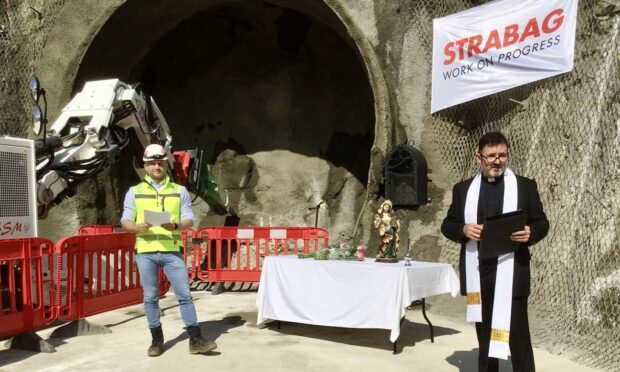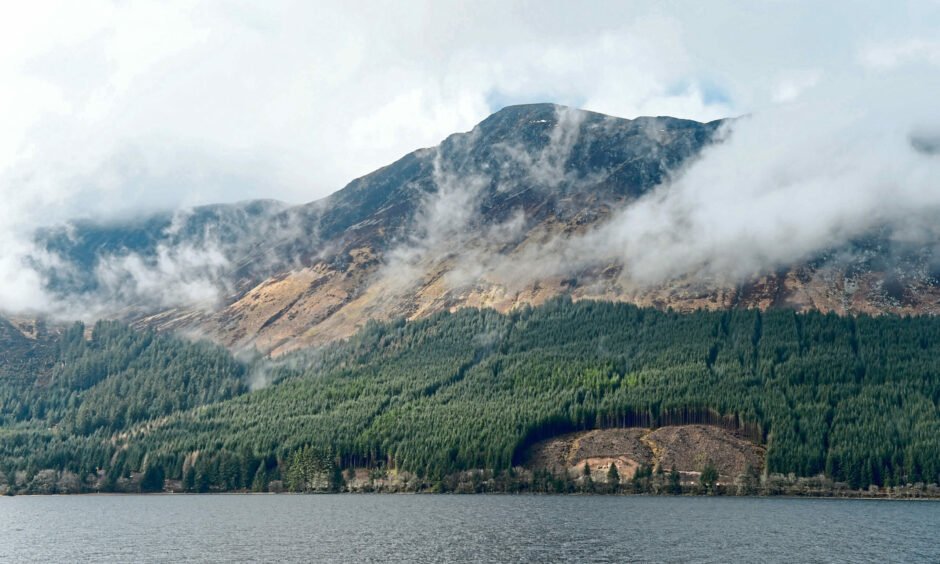A special service to bless and say prayers at a Lochaber tunnel has taken place.
Fr Danny Convey was invited to lead a very unusual religious service at the mouth of Coire Glas ahead of work beginning, inviting Santa Barbara to become the Godmother of the works.
While Fr Danny, the parish priest based in Roy Bridge, is used to blessing homes and cars, tractors, even pets, he had never had such a request as this before.
He was invited by the international and local workers to perform the ceremony on the far shore of Loch Lochy in the company of a large workforce.
Fr Danny said giving a very special blessing at the opening ceremony of SSE Coire Glas Hydro scheme was “one of the most unusual ceremonies” he had been involved in.
The Coire Glas scheme is an ambitious energy infrastructure projects the UK has ever seen.
Coire Glas blessing
The prayers to Santa Barbara and the handing over the keys to her – is an ancient ceremony performed around the world for miners.
It is a cherished tradition of many centuries featuring Santa Barbara.
So, there was an air of expectancy as Fr Danny stood at the portal of the tunnel at the opening ceremony of the largest hydro storage scheme to be developed in the UK for more than 40 years.
Highland councillors on Coire Glas site visit https://t.co/7tXS1Y8yFl pic.twitter.com/fzTs8xPA4W
— The Press & Journal (@pressjournal) October 20, 2018
Addressing more than a hundred people, connected with the scheme, Fr Danny explained that in invoking the protection of St Barbara, it was not idolatry or even good luck, but “a reminder that God is faithful and cares for his people”.
A statue of Santa Barbara had been brought from Rome for the occasion.
As Fr Danny blessed the statue and the tunnel, he explained: “This blessing is an invocation, it invokes goodness from God so that this tunnel, this project itself becomes a potency for good.
“So, we bless this tunnel that the skill, talents and labour of humanity bring praise to God and protection for all who enter and work here.”
Fr Danny blessed the entrance with holy water and prayer.
Then the statue of Santa Barbara was lifted carefully into a cage standing at the opening of the tunnel where workers will pass by her every day.
Fr Danny was warmly thanked, by workers, for giving this meaningful and significantly important and long-established opening ceremony blessing.
The ceremonial breaking out of the tunnel then took place.
Who is Santa Barbara?
Few today may know of Saint Barbara, but she has in fact been venerate from the 9th century onwards.
Earliest records of Barbara’s life show that she was born in the third century and lived in today’s Turkey.
Saint Barbara again! This time in Palma’s Santa Eulàlia church! Wasn’t expecting to see her in here. pic.twitter.com/fGjIj1ELEO
— Jessica Minieri (@jessica_minieri) April 11, 2023
She was the daughter of a rich and overbearing pagan named Dioscorus who rigorously guarded her and cruelly kept her locked up in a tower.
Dioscorus had a private bath house with two windows built for his daughter when he was away on business.
Barbara, having secretly become a Christian, installed a third window in honour of the Holy Trinity.
She rejected an offer of marriage that she received through her father and when she acknowledged herself to be a Christian, she was dragged before the Emperor and tortured.
Barbara held fast to her faith though and every morning her wounds were miraculously healed.
Torches that were used to burn her went out as soon as they came near her.
Finally, she was condemned to death by beheading, and it is said that it was her father himself who executed her.
However, on the way home he was struck by lightning and his body consumed by flames.
Barbara was buried by a Christian, Valentinus, and her tomb became the site of miracles. Later canonised, St Barbara’s feast day is December 4.
Barbara’s association with the lightning that killed her father has caused her to be invoked against lightning and fire; by association with explosions, she also became the patron saint of artillery men, armourers, military engineers, gunsmiths, firemen and anyone else who worked with cannon and explosives.
Following the widespread use of gunpowder in mining in the 1600s, she was also adopted as the patron saint of miners, tunnellers and other underground workers.
Within the tunnelling industry, as a long-standing tradition, one of the first tasks for each new tunnelling project is to establish a small shrine to St Barbara at the tunnel portal and this is often followed with a dedication and an invocation to St Barbara for the protection of all who work on the project during the construction period.

